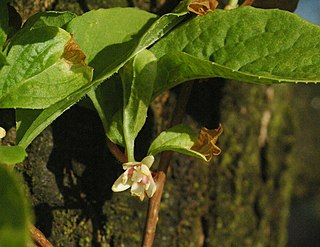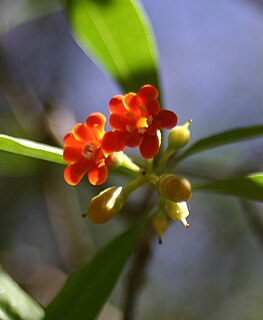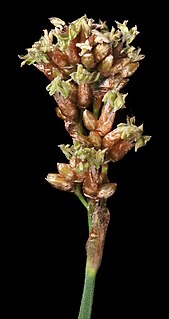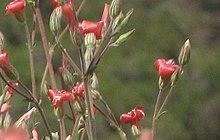
Commelinales is the botanical name of an order of flowering plants. It comprises five families: Commelinaceae, Haemodoraceae, Hanguanaceae, Philydraceae, and Pontederiaceae. All the families combined contain over 885 species in about 70 genera; the majority of species are in the Commelinaceae. Plants in the order share a number of synapomorphies that tie them together, such as a lack of mycorrhizal associations and tapetal raphides. Estimates differ as to when the Comminales evolved, but most suggest an origin and diversification sometime during the mid- to late Cretaceous. Depending on the methods used, studies suggest a range of origin between 123 and 73 million years, with diversification occurring within the group 110 to 66 million years ago. The order's closest relatives are in the Zingiberales, which includes ginger, bananas, cardamom, and others.

Ceratophyllaceae is a cosmopolitan family of flowering plants including one living genus commonly found in ponds, marshes, and quiet streams in tropical and in temperate regions. It is the only extant family in the order Ceratophyllales. Species are commonly called coontails or hornworts, although hornwort is also used for unrelated plants of the division Anthocerotophyta.

Geraniales are a small order of flowering plants, included within the rosid subclade of eudicots. The largest family in the order is Geraniaceae with over 800 species. In addition, the order includes the smaller Francoaceae with about 40 species. Most Geraniales are herbaceous, but there are also shrubs and small trees.

Geraniaceae is a family of flowering plants placed in the order Geraniales. The family name is derived from the genus Geranium. The family includes both the genus Geranium and the garden plants called geraniums, which modern botany classifies as genus Pelargonium, along with other related genera.

The Francoaceae are a small family of plants in the order Geraniales, including the genera Francoa, commonly known as bridal wreaths, and Tetilla. The Francoaceae are recognized as a family under various classification schemes but under the APG III system the Francoaceae are included within the Melianthaceae. In the APG IV system the Francoaceae are again recognized as a family, with Melianthaceae included in the circumscription of Francoaceae.

Oxalidales is an order of flowering plants, included within the rosid subgroup of eudicots. Compound leaves are common in Oxalidales and the majority of the species in this order have five or six sepals and petals. The following families are typically placed here:

Hemerocallidoideae is the botanical name of a subfamily of flowering plants, part of the family Asphodelaceae sensu lato in the monocot order Asparagales according to the APG system of 2016. Earlier classification systems treated the group as a separate family, the Hemerocallidaceae. The name is derived from the generic name of the type genus, Hemerocallis. The largest genera in the group are Dianella, Hemerocallis (15), and Caesia (11).

The Angiosperm Phylogeny Group, or APG, is an informal international group of systematic botanists who collaborate to establish a consensus on the taxonomy of flowering plants (angiosperms) that reflects new knowledge about plant relationships discovered through phylogenetic studies.

The Portulacaceae are a family of flowering plants, comprising 115 species in a single genus Portulaca. Formerly some 20 genera with about 500 species, were placed there, but it is now restricted to encompass only one genus, the other genera being placed elsewhere. The family has been recognised by most taxonomists, and is also known as the purslane family. It has a cosmopolitan distribution, with the highest diversity in semiarid regions of the Southern Hemisphere in Africa, Australia, and South America, but with a few species also extending north into Arctic regions. The family is very similar to the Caryophyllaceae, differing in the calyx, which has only two sepals.

Asphodelaceae is a family of flowering plants in the order Asparagales. Such a family has been recognized by most taxonomists, but the circumscription has varied widely. In its current circumscription in the APG IV system, it includes about 40 genera and 900 known species. The type genus is Asphodelus.

Schisandraceae is a family of flowering plants with 3 known genera and a total of 92 known species. Such a family has been recognized by most taxonomists, at least for the past several decades. Before that, the plants concerned were assigned to family Magnoliaceae and Illiciaceae.

Siparunaceae is a family of flowering plants in the magnoliid order Laurales. It consists of two genera of woody plants, with essential oils: Glossocalyx in West Africa and Siparuna in the neotropics. Glossocalyx is monospecific and Siparuna has about 74 known species.
The APG II system of plant classification is the second, now obsolete, version of a modern, mostly molecular-based, system of plant taxonomy that was published in April 2003 by the Angiosperm Phylogeny Group. It was a revision of the first APG system, published in 1998, and was superseded in 2009 by a further revision, the APG III system.

Dasypogonaceae is a family of flowering plants, one that has not been commonly recognized by taxonomists; the plants it contains were usually included in the family Xanthorrhoeaceae. If valid, Dasypogonaceae includes four genera with 16 species.

Theophrastoideae is a small subfamily of flowering plants in the family Primulaceae. It was formerly recognized as a separate family Theophrastaceae. As previously circumscribed, the family consisted of seven genera and 95 species of trees or shrubs, native to tropical regions of the Americas.

Staphyleaceae is a small family of flowering plants in the order Crossosomatales, native to Europe, temperate and tropical Asia and the Americas. The largest genus Staphylea, which gives the family its name, contains the "bladdernut" trees. The family includes three genera with more than 40 known species.

Tecophilaeaceae is a family of flowering plants, placed in the order Asparagales of the monocots. It consists of nine genera with a total of 27 species.

The Anarthriaceae are a family of three genera, Anarthria, Hopkinsia and Lyginia of flowering plants, now included in Restionaceae following APG IV (2016). The family is accepted in the Angiosperm Phylogeny Group's classification system, APG III system, but is not considered a separate family in many other taxonomic systems. The three genera are herbaceous but differ greatly in characteristics.
Medusandra is a genus of flowering plants in the family Peridiscaceae. It has two species, Medusandra richardsiana and Medusandra mpomiana. M. richardsiana is the most common and well known. Both species are native to Cameroon and adjacent countries.

LedocarpaceaeMeyen was a small flowering plant family of shrubs native to western South America. Under the APG III system of classification it is considered to be a part of the Vivianiaceae.



















